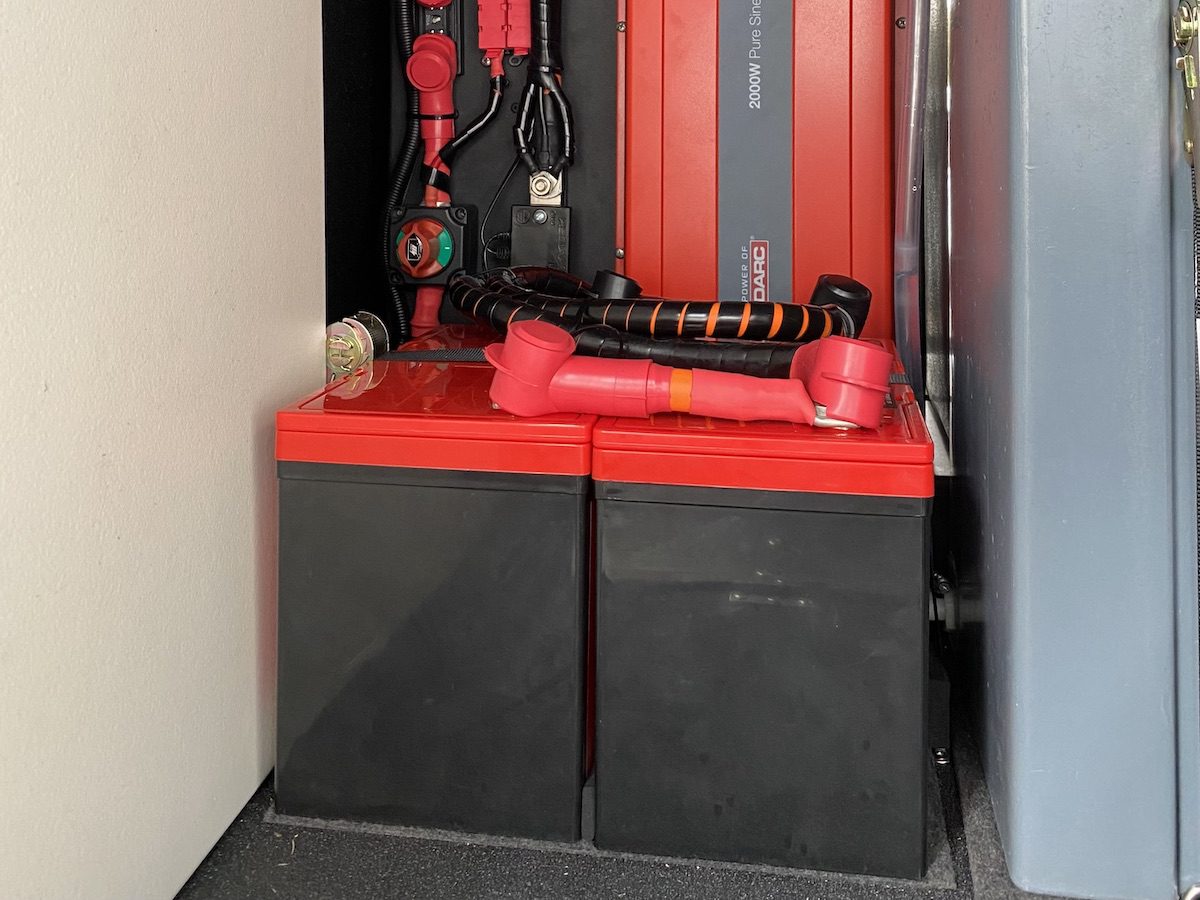Note: This article contains affiliate links to My Generator and Outback Equipment. If you click through and make a purchase, we earn a small commission at no extra cost to you.
Dual battery capacity in your camper, 4×4, RV, caravan or motorhome is a hot topic. The list of electrical accessories we “need” keeps growing all the time.
Items once considered luxuries when travelling are now must-haves… coffee machines, sound systems, large screen TVs, air conditioning, electric heating, hair driers, microwave ovens, and so on.
As our electrical demands grow, battery capacity keeps growing to match the demand. Many dual battery system now have 2, 4, 6 or even more batteries wired up together.
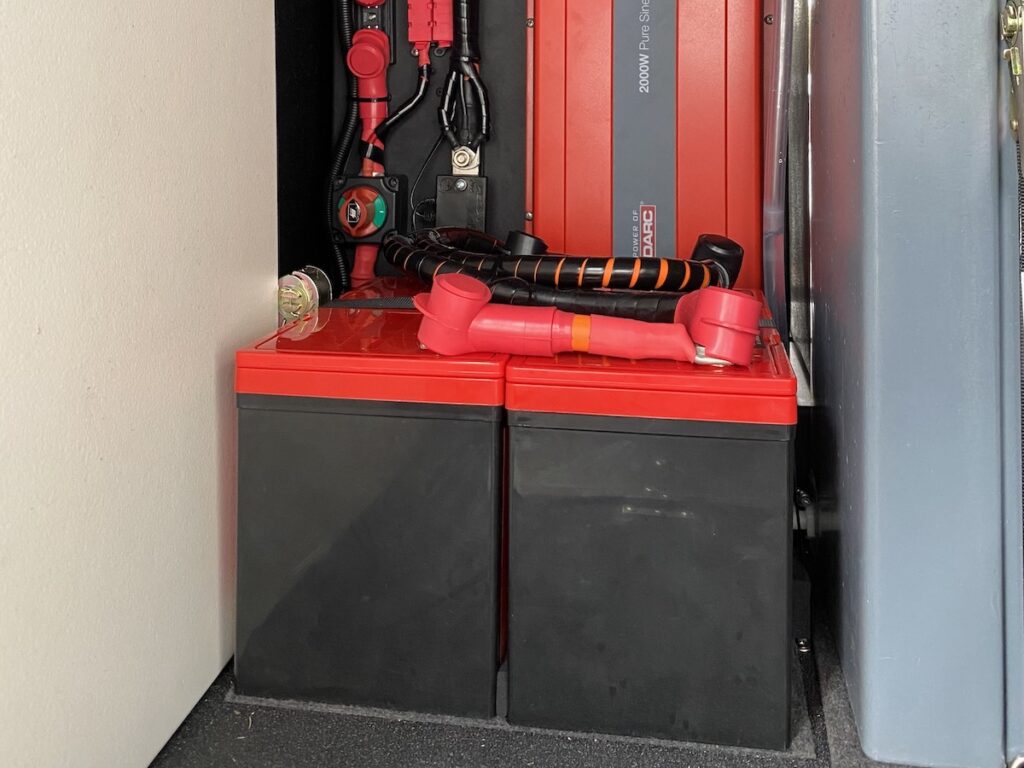
But there are plenty of reports of these batteries failing early. We’ll explain
- why they fail early,
- how to avoid this, and
- show you how to connect batteries in parallel the correct way.
It’s all to do with what’s called “unbalanced” charging and “balanced” charging.
But first, let’s go through a few basic guidelines you should always follow when connecting batteries in parallel.
- Guidelines For Connecting Batteries in Parallel
- Unbalanced Charging
- Current Is Like Water… Kind Of
- Why You Should Replace All Batteries At The Same Time
- Balanced Charging
- A “Perfectly” Balanced Charging System
- A Simpler Option?
- Where To Connect The Supply Cables For Your Devices?
- Is Balanced Charging Worth The Effort?
Guidelines For Connecting Batteries in Parallel
Rule #1 is to never assume you can connect all battery brands in parallel. Some manufacturers don’t recommend it. Do your homework, check with the manufacturer before you buy.
Can you safely connect lithium batteries in parallel? It depends on the internal construction of the battery. Check with the manufacturer first.
Price is a rough guide here. Generally speaking, cheap lithium batteries are less likely to be suitable for parallel connection than more expensive ones. But not always… check with the manufacturer first.
Some manufacturers specify limits on how many batteries you can connect in parallel. For example REDARC Electronics specify a maximum of:
- Four 60AH lithium batteries,
- Six 100Ah lithium batteries, and
- Six 200Ah lithium batteries.
Rule #2 is to only ever connect batteries with the same chemistry – AGM to AGM or Lithium to Lithium. Never mix the two.
Rule #3 is to only install new batteries. And if one battery fails, replace them all. If you don’t, it’s highly likely you’ll continue having premature battery failures.
If you have lithium batteries, you’ll normally be able to replace only the failed battery. But… check with the manufacturer first.
If you have two older batteries and want to connect them in parallel, contact the manufacturer. Ask them what they recommend. They’ll most likely say you can’t connect them in parallel… or you can, but they’ll fail quickly.
Rule #4 is to make sure you size the cables correctly. Undersized cables cause voltage drops and in the worst case can start fires.
If you’re not sure about cable sizing, we’ve put together a detailed article on How To Size Automotive Wiring with bonus auto cable size calculators and a cable size chart here.
Related Resources: Download Excel versions of our Cable Calculators from our Free Resources page
+
a bonus Voltage Drop Calculator.
Unbalanced Charging
Before we go on, let’s be clear on a couple of things. In the examples we’re about to show you, assume:
- All the cabling in each example is the same size and type, and is correctly sized.
- All terminal connectors are the same type.
- All the batteries are identical specifications (same age, same capacity, same brand and either AGM or Lithium).
Okay, moving on…
One of the most common ways to connect batteries in parallel is to string them together. You start at one end and join the batteries together in a string.
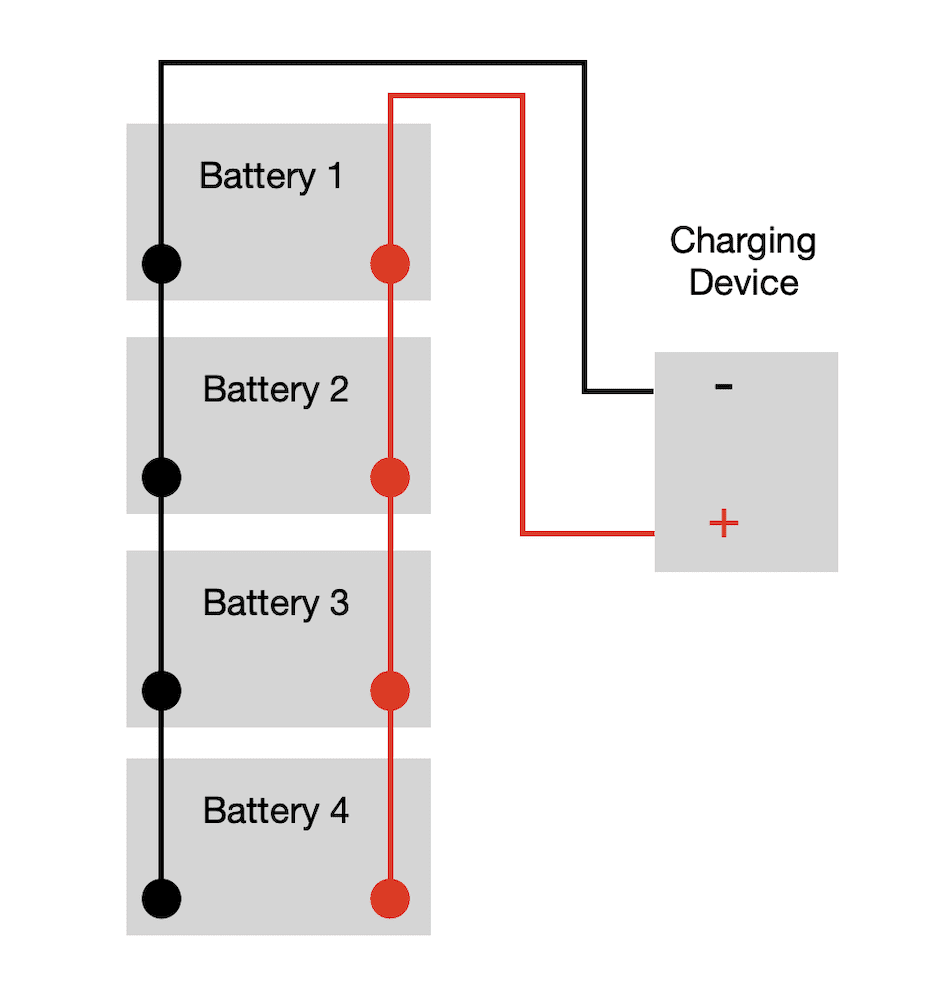
This is often done because it’s easier (or cheaper) to start at one end. The charging device may be at one end of the battery bank, so it makes sense to start at that end, right?
Ah, no. There’s a problem with this setup.
Battery 1 works harder than Battery 2 and so on down the string. Why? Because it gets charged and discharged more quickly, because the cable run is shorter.
Think of current flow as being like water flow. Water always takes the path of least resistance… as does electrical current.
Current Is Like Water… Kind Of
Imagine the batteries are water tanks, the cable is water piping, and the charging device is a water supply. Tank 1 will fill slightly quicker than Tank 2 and so on down the line. And Tank 1 will also empty slightly quicker than Tank 2 and so on down the line.
It’s exactly the same with current. Battery 1 has the path of least resistance, so it will charge and discharge more quickly than Battery 2.
Over time, Battery 1 will most likely fail first. Why? Because it’s working harder than the other batteries.
If you have two batteries in parallel, it probably won’t matter a great deal… assuming the cables connecting the batteries are short. But with six or eight batteries in a parallel string? The current flow to and from the last battery will be way less than for the first battery.
That’s a big problem.
To make matters worse, if you have multiple batteries in parallel then its likely you’re running some seriously power-hungry devices. So the first battery is going to get smashed every time you use one of these devices.
In contrast, the last battery in the string will be kicking back and taking it easy down there on the end… not doing too much work at all.
The first battery will fail long before the last battery, all else being equal. But when one battery fails, you need to replace them all. That’s right, all of them.
If you have 6 or 8 batteries, then that’s an expensive exercise.
Why? If one battery fails, can’t we simply replace the dead battery? Unfortunately, it’s not that simple.
Why You Should Replace All Batteries At The Same Time
As a battery repeatedly charges and discharges, its internal resistance changes over time.
In simple terms, when you have a mix of batteries at different stages of their lives you’ll confuse the charging device. It will either overcharge the older batteries or undercharge the new battery.
Either scenario is bad.
Overcharging causes heat build-up which can lead to the battery casing distorting, melting and potentially failing. In the most severe cases, the battery can explode.
Undercharging shortens the life of the new battery, leading to early failure.
By replacing all the batteries at once, you start with a bank of batteries with similar internal resistance. Then if they’re all working together, they have the best chance of balancing each other and degrading equally over time. This way you maximise the life of all the batteries.
Lithium batteries have an internal battery management system (BMS) which optimises the state of charge across the internal cells. So they’re less likely to suffer from overcharging or undercharging.
However, not all lithium batteries are created equal. Check with the manufacturer before you replace one lithium battery in a bank of lithium batteries.
How do we avoid the expense of replacing multiple batteries? How do we maximise the life of all the batteries?
By balancing the charging…
Balanced Charging
The easiest way to achieve balanced charging is to wire them as shown below.
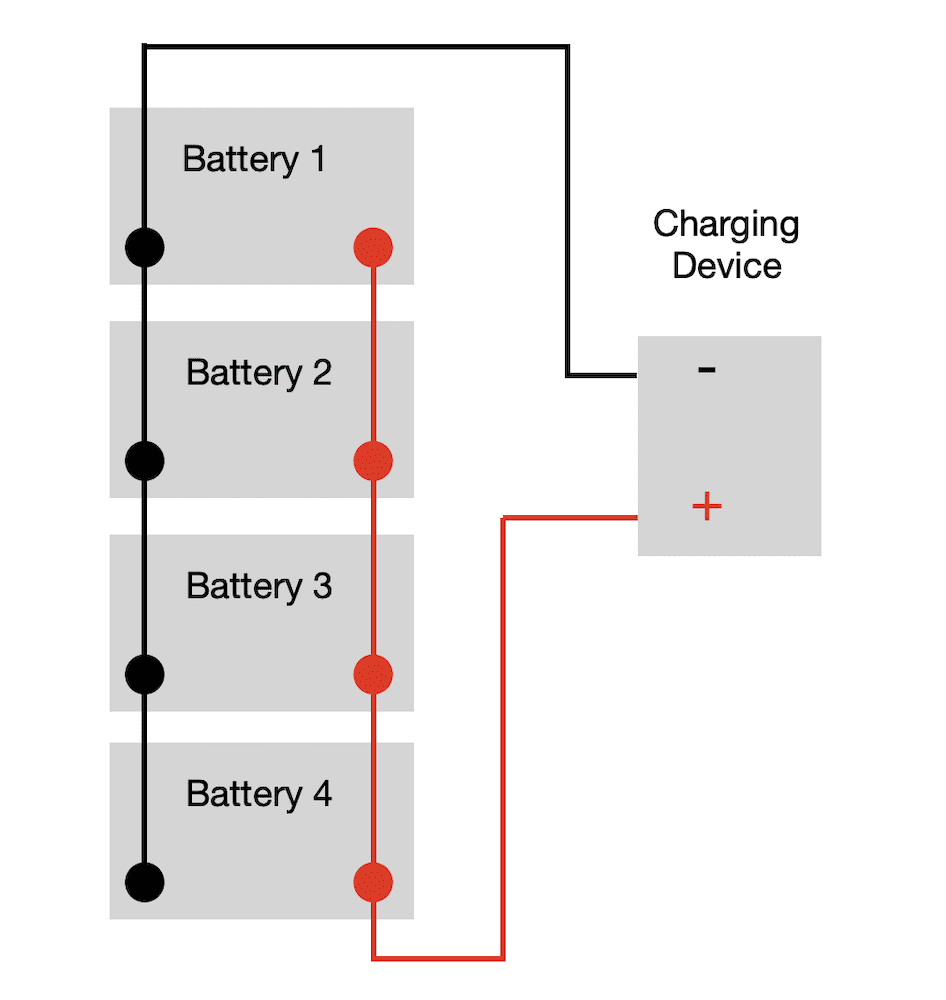
This is the simplest and most cost-effective way to achieve balanced charging.
Make all the bridging cables between batteries equal length and as short as possible, and the supply cables from the charging device as short as possible. This way, you’ll minimise resistance within each cable and each battery will “see” the same cable length (resistance level).
It’s still not a perfectly balanced system. However, this is a far better option than simply stringing them together from one end to another. And if you have an odd number of batteries, this is really the only practical way to connect batteries in parallel.
In reality, no setup will give you perfectly balanced charging. There are too many variables, like:
- variations in how terminal connectors are attached to the cables,
- how terminal connectors are attached to the battery terminals, and
- variations in the internal chemistry of each battery, which affects internal resistance.
Even variations in ambient temperature affect resistance. For example, say you have a bank of batteries in parallel mounted under the floor of a motorhome. If one end of the bank is closer to the engine, it’ll be hotter. This can be enough to change the system resistance slightly.
Quite simply, there too many variables to ever achieve a perfectly balanced system.
You might have read about something called a “perfectly balanced charging” system. What’s it all about? Is it worth the effort?
A “Perfectly” Balanced Charging System
Perfectly balanced charging is based on one simple idea – the cables runs to each battery must be identical lengths. This way, the cable resistance will be identical therefore each battery will charge and discharge equally.
Here’s an example of a perfectly balanced system using 4 batteries. Note this only works with even numbers of batteries.
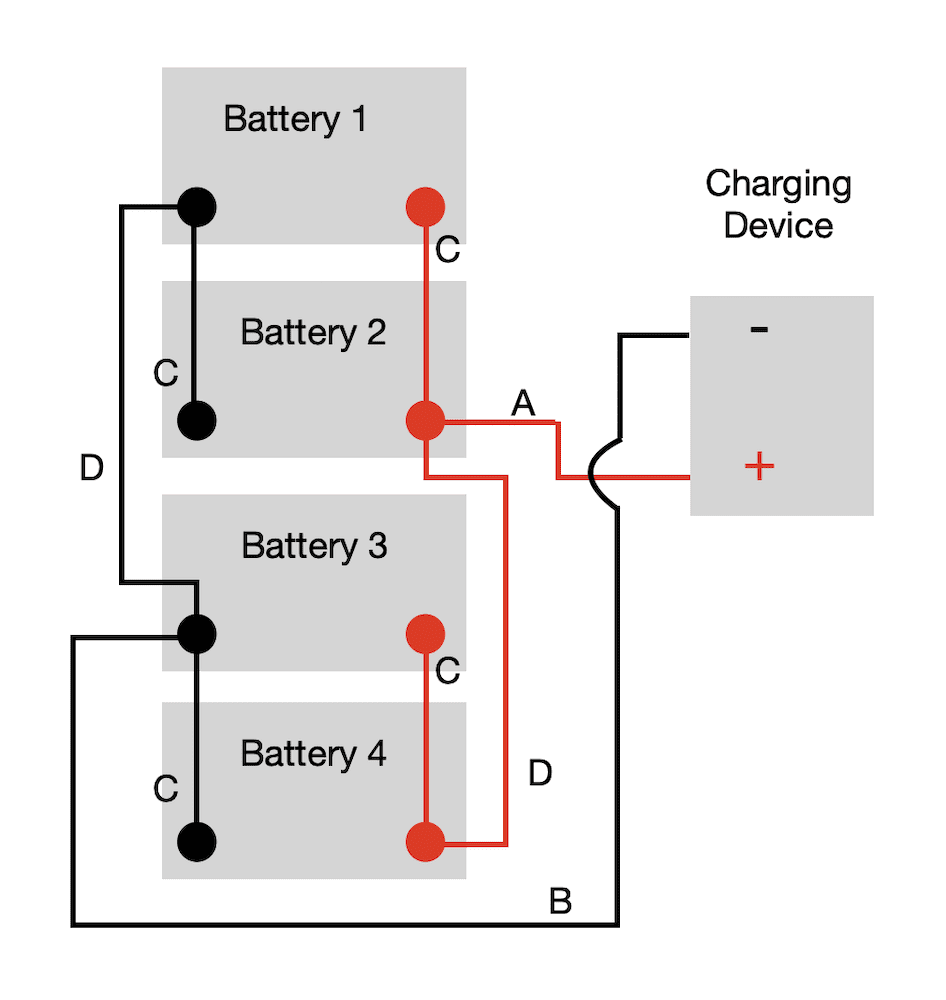
The first thing you’ll notice is how complex the cabling is compared to Figure 2 above.
The theory is, each battery in the system has identical lengths of cable runs. I’ve labelled them so you can do the exercise yourself. You’ll notice the cable runs for every battery are indeed equal, A+B+C+D.
That’s great. But it’s no different to the simple setup in Figure 2. It too has identical length cable runs for each battery.
And just like the balanced system in Figure 2, a “perfectly” balanced system suffers from the same issues:
- variations in quality of connection between cable ends and terminal connectors,
- how terminal connectors are attached to the battery terminals,
- variations in the internal chemistry of each battery, and
- outside influences like temperature variations.
You’ll see plenty of articles extolling the virtues of perfectly balanced charging systems. But they don’t stack up. They’re prone to exactly the same issues as the much simpler system shown in Figure 2.
A Simpler Option?
There’s one other option when you’re figuring out how to connect batteries in parallel and maintain balanced charging.
You could run two copper busbars (one for +ve and the other for -ve). Then connect each battery using individual cables from the battery terminals to the busbars.
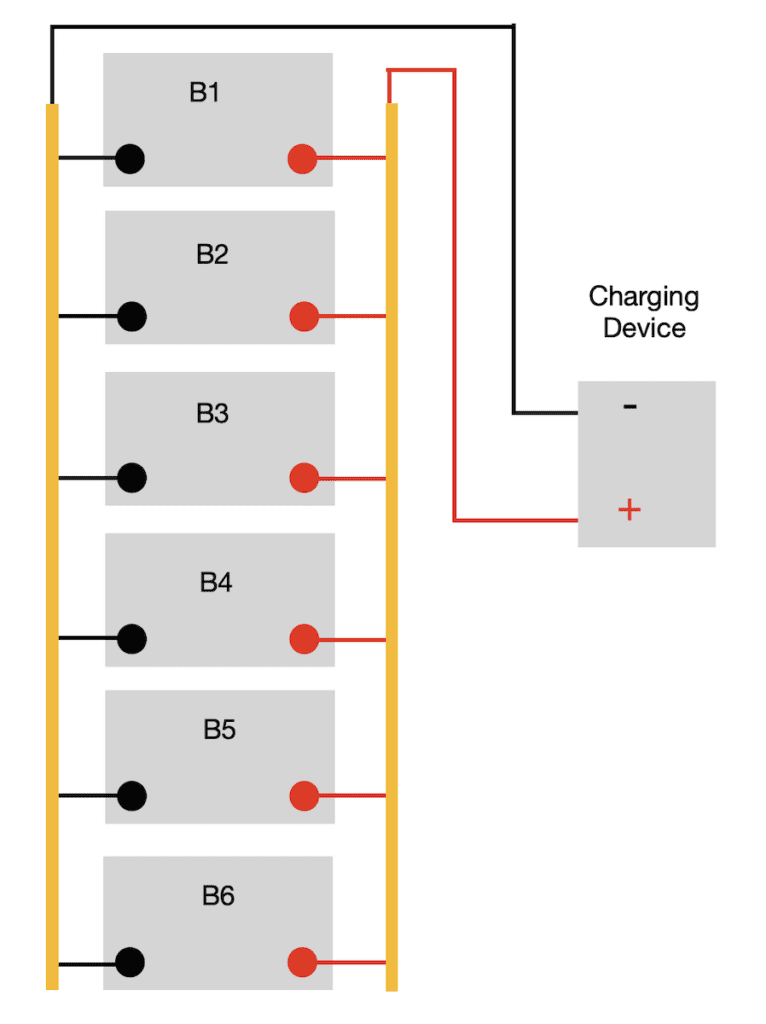
All positive cables (to battery from busbar) should be identical lengths, as should all negative cables. The resistance through the busbar will be negligible, assuming it’s sized correctly.
And it works for odd or even numbers of batteries in parallel, unlike the “perfectly” balanced charging system in Figure 3 above.
Whether a busbar is a practical option for your installation is something you’ll need to decide.
Where To Connect The Supply Cables For Your Devices?
Sometimes you’ll see a parallel battery bank wired as per Figure 2, but then the load cables (positive and negative supply cables out to your devices) are connected to the nearest convenient battery terminal.
Don’t do this.
Always connect the loads to the same battery terminals as the charging device’s cables. This way, the battery bank will discharge more evenly across the batteries and you’ll prolong battery life.
Is Balanced Charging Worth The Effort?
Do you have a bank of batteries in parallel… and one or more batteries keep failing? If so, then I’d be checking closely how it’s wired up.
Chances are, it’ll be unbalanced.
Check the wiring. You’ll find:
- Some suppliers will go with the unbalanced configuration because it’s the cheapest (or they don’t know what they’re doing),
- Some will go with the balanced charging system as per Figure 2 because it’s proven to work well,
- Occasionally a supplier will use busbars in certain applications, and
- Very few (if any) will set up a “perfectly” balanced charging system.
The balanced charging system is the obvious choice (shown again below). It’s a good compromise between price, cable lengths, and practicality.

Busbars are also an excellent option. However, they can be tricky to protect against accidental short-circuits… especially in a moving vehicle.
What of the “perfectly” balanced system shown in Figure 3? For a bank of batteries all in row, forget it. But it can be used when you have blocks of batteries, say 2 rows of 2 or 2 rows of 3. It’ll work fine… just don’t expect it to be “perfect”.
And finally, if you have an unbalanced system (Figure 1), then I recommend you change it to a balanced system as soon as possible.
Whatever you decide will have implications for battery life in a 12V parallel battery system… and implications for your hip pocket.
My Generator stock a huge range of batteries and power system components for your 4WD, RV, caravan or camper. Go here to see their range.
Go here for more How-To Guides and tips.

Free Download:
The 8 Essentials You Need To Live Off-Grid
…and don’t worry, eating raw fish isn’t one of them!
Any questions or comments? Go to the Comments below or join us on Pinterest, Facebook or YouTube.
Any errors or omissions are mine alone.

